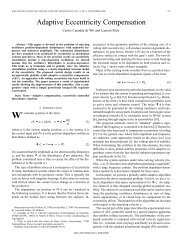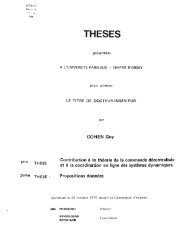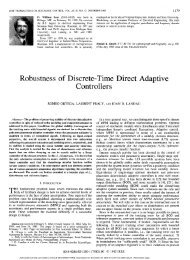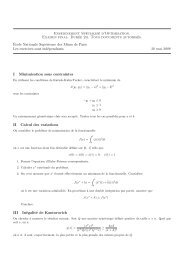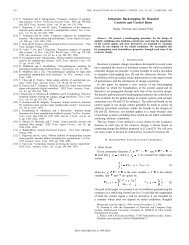Copyright © by SIAM. Unauthorized reproduction of this article is ...
Copyright © by SIAM. Unauthorized reproduction of this article is ...
Copyright © by SIAM. Unauthorized reproduction of this article is ...
You also want an ePaper? Increase the reach of your titles
YUMPU automatically turns print PDFs into web optimized ePapers that Google loves.
HOMOGENEOUS OBSERVER DESIGN 1841Appendix C. Pro<strong>of</strong> <strong>of</strong> Lemma 2.13. The pro<strong>of</strong> <strong>of</strong> <strong>th<strong>is</strong></strong> lemma <strong>is</strong> divided intothree parts.1. We first show, <strong>by</strong> contradiction, that there ex<strong>is</strong>ts a real number c 0 sat<strong>is</strong>fyingη 0 (θ) − cγ 0 (θ) < 0 ∀ θ ∈ S r0 , ∀ c ≥ c 0 .Suppose there <strong>is</strong> no such c 0 . Th<strong>is</strong> means there <strong>is</strong> a sequence (θ i ) i∈N in S r0which sat<strong>is</strong>fiesη 0 (θ i ) − iγ 0 (θ i ) ≥ 0 ∀ i ∈ N .The sequence (θ i ) i∈N lives in a compact set. Thus we can extract a convergentsubsequence (θ il ) l∈N which converges to a point denoted θ ∞ .As the functions η 0 and γ 0 are bounded on S r0 and γ 0 takes nonnegativevalues, 8 γ 0 (θ il ) must go to 0 as i l goes to infinity. Since the functions η 0 andγ 0 are continuous, we get γ 0 (θ ∞ ) = 0 and η 0 (θ ∞ ) ≥ 0, which <strong>is</strong> impossible.Consequently, there ex<strong>is</strong>t c 0 and ε 0 > 0 such that(C.1) η 0 (θ) − cγ 0 (θ) ≤ −ε 0 < 0 ∀ θ ∈ S r0 , ∀ c ≥ c 0 .Moreover, since the functions η 0 and γ 0 are homogeneous in the standardsense (see Remark 2.6), we have the second inequality in (2.4).Following the same argument, we can find positive real numbers c ∞ and ε ∞such that(C.2) η ∞ (θ) − cγ ∞ (θ) < −ε ∞ ∀ θ ∈ S r∞ , ∀ c ≥ c ∞ ,and the third inequality in (2.4) holds.In the rest <strong>of</strong> the pro<strong>of</strong>, letc 1 = max{c 0 ,c ∞ }, ε 1 = min{ε 0 ,ε ∞ } .2. Since η and γ are homogeneous in the 0-limit, there ex<strong>is</strong>ts λ 0 such that, forall λ ∈ (0,λ 0 ] and all θ ∈ S r0 , we haveη(λ r0 ⋄ θ) ≤ λ d0 η 0 (θ) +λ d0 ε 14 , λd0 γ 0 (θ) − λ d0 ε 14c 1≤ γ(λ r0 ⋄ θ) ,which readily givesη(λ r0 ⋄ θ) − c 1 γ(λ r0 ⋄ θ) ≤ λ d0 η 0 (θ) +λ d0 ε 12 − c 1λ d0 γ 0 (θ) .Using (C.1), we getη(λ r0 ⋄ θ) − c 1 γ(λ r0 ⋄ θ) ≤ −λ d0 ε 12and therefore, since γ takes nonnegative values,∀ λ ∈ (0,λ 0 ] , ∀ θ ∈ S r0 ,η(λ r0 ⋄ θ) − cγ(λ r0 ⋄ θ) ≤−λ d0 ε 12∀ λ ∈ (0,λ 0 ] , ∀ θ ∈ S r0 , ∀ c ≥ c 1 .8 Indeed, if we had γ 0 (x) < 0 for some x in R n \{0}, <strong>by</strong> letting ɛ = − γ 0(x), the homogeneity in2the 0-limit <strong>of</strong> γ would give a real number λ> 0 sat<strong>is</strong>fying γ(λr 0 ⋄x)λ d ≤ γ0 0 (x) +ɛ = γ 0(x)< 0. Th<strong>is</strong>2contradicts the fact that γ takes nonnegative values only. Also <strong>by</strong> continuity we have γ 0 (0) ≥ 0.<strong>Copyright</strong> © <strong>by</strong> <strong>SIAM</strong>. <strong>Unauthorized</strong> <strong>reproduction</strong> <strong>of</strong> <strong>th<strong>is</strong></strong> <strong>article</strong> <strong>is</strong> prohibited.




